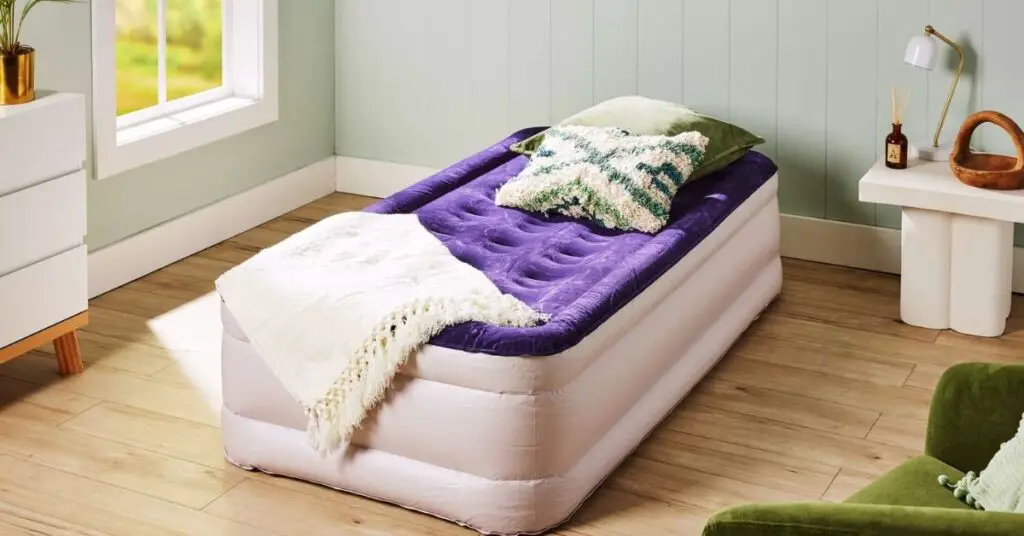Yes, air mattresses naturally deflate due to material stretch, temperature changes, and small leaks.
Do Air Mattresses Naturally Deflate?
Let’s be honest, nothing’s worse than waking up on the floor after a night on your trusty air mattress. So why does this happen? Yes, air mattresses naturally deflate over time. It’s frustrating, but there are several reasons this happens. Let’s dive into the causes and what you can do to get a better night’s sleep.
Why Air Mattresses Lose Air
- Stretching and Settling: Brand new air mattresses need a “break-in” period. Especially on the first night or two, the material will stretch, and it might feel like the mattress is rapidly losing air. This is normal and should subside after a few uses.
- Temperature Changes: Whoa, did it get cold in here? Temperature drops cause the air inside your mattress to contract, making it feel softer. Warm it up again, and the pressure will increase.
- Small Leaks, Big Problems: Sadly, slow leaks are a common culprit. Punctures can be caused by pets, sharp objects, or even overinflation that stresses the seams. It might not be a huge hole – even the tiniest one can ruin your sleep.
How to Keep Your Air Mattress Inflated
Let’s get practical – no one wants to sleep on the floor! Here are some tips to minimize air loss:
- Break It In: Inflate your new mattress and let it sit for a few hours, topping it off as needed. This helps it stretch and settle.
- Keep a Steady Temperature: If possible, keep the room temperature consistent overnight, especially if it’s chilly out.
- Avoid Overinflating: Follow the manufacturer’s instructions for how firm it should be. Overinflating puts stress on the seams, increasing the risk of leaks.
- Leak Check: Regularly inspect your mattress for punctures, especially after moving it or if you have pets.
Table 1: Common Leak Locations:
| Area of Mattress | Why It’s Vulnerable |
| Seams | Manufacturing flaws or stress from overinflation |
| Valve | May not seal properly, or could be damaged |
| Surface | Prone to punctures |
Finding a Leak
Okay, detective, time to get to the bottom of this deflation mystery! Here are some methods to find even the smallest leak:
- The Soapy Water Test: Inflate the mattress, mix a bit of dish soap with water, and apply it to the surface, seams, and valve. Bubbles mean you’ve found your air thief.
- The Listening Test: Inflate the mattress and hold it near your ear. Listen closely for any hissing sounds that could reveal a leak.
- The Submersion Test: This works best for smaller sections like the valve area. Submerge the suspected area in water and look for bubbles.
Table 2: Leak Locator Methods
| Method | Pros | Cons |
| Soapy Water | Easy and effective | Can be messy |
| Listening Test | Simple | Small leaks might be hard to hear |
| Submersion Test | Good for pinpointing leaks in small areas | Requires access to water, not ideal for whole mattress |
Patching Up a Leaky Mattress
Found the source of your leak? Great! Most air mattresses come with patch kits, but if not, you can easily find repair kits online or at sporting goods stores. Here’s the fix-it process:
- Deflate and Clean: Make sure the mattress is completely deflated and the area around the leak is clean and dry.
- Mark the Spot: Use a marker or piece of tape to clearly mark the location of the leak.
- Patch It Up: Follow the instructions on your patch kit – typically, you’ll apply glue to a patch slightly larger than the leak and press it firmly onto the mattress.
- Wait and Test: Let the glue dry completely according to the instructions (usually several hours). Then, re-inflate the mattress and check for any remaining air escaping.
Choosing a Durable Air Mattress
Prevention is always better than repair! When choosing an air mattress, consider these factors for better durability:
- Material Matters: Thick PVC is generally tougher than vinyl. Some brands offer puncture-resistant materials for ultimate peace of mind.
- Built for Strength: Look for mattresses with internal coil or beam construction for support and less strain on the material.
- Read the Reviews: See what other users say about a particular mattress’s durability and how well it withstands regular use.
Table 3: Mattress Construction Types
| Type | Pros | Cons |
| Basic coil | Affordable, simple design | Less supportive than other types |
| Double-height | Higher off the ground, more comfy for guests | Bulkier to store |
| Internal beams | Added support and stability | Can be more expensive |
Maximizing the Lifespan of Your Air Mattress
With a little care, you can get the most out of your air mattress:
- Storage Savvy: When not in use, deflate the mattress completely and store it in a protective bag or container.
- Ground Rules: Place a blanket or tarp underneath the mattress for extra protection from sharp objects on the floor.
- Weight Limits: Respect the manufacturer’s recommended weight limit to avoid excess stress on the seams.
- No Jumping Jacks: Treat your air mattress gently! Avoid jumping or any activities that put undue pressure on it.
Conclusion- Do Air Mattresses Naturally Deflate?
Do air mattresses naturally deflate? Yes, they do – several factors can contribute to air loss. However, by understanding those factors, taking preventative measures, and patching leaks promptly, you can keep your air mattress inflated and comfy for more restful nights.

